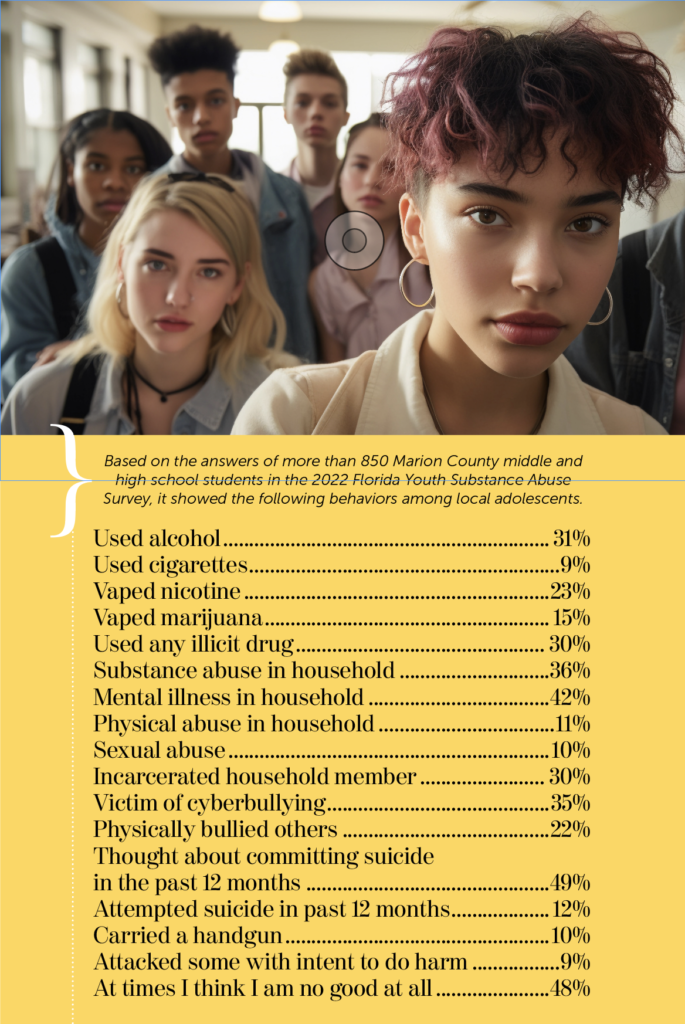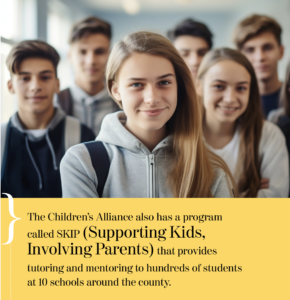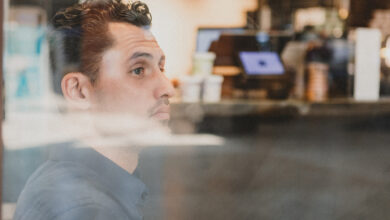Author’s note: As a longtime observer, supporter and the current board chairman of the Marion County Children’s Alliance, I have tracked the state of children in our community over the past 22 years. In that time, I have witnessed the growth of the Alliance and the programs it has helped initiate with its partners. The results have been positive and beneficial for our entire community, but particularly for Marion County’s most at-risk children. The Alliance’s successes are the community’s successes.
 In 2022, 35 percent of middle and high school students in Marion County said they contemplated suicide. An alarming 12 percent said they attempted to kill themselves.
In 2022, 35 percent of middle and high school students in Marion County said they contemplated suicide. An alarming 12 percent said they attempted to kill themselves.
Almost half, 45 percent, lived in homes where parents were separated or divorced.
One in five children in Marion County lived in poverty.
Some 41 percent said they have used alcohol or drugs, with 21 percent having done so in the previous 30 days.
Those statistics, the most recent available, come from the 2022 Florida Youth Substance Abuse Survey conducted annually by the Florida Department of Children and Families. The survey, which included 851 Marion County middle and high school students, paints a statistical portrait of what it’s like to be an adolescent in our community.
It also serves as a guide for organizations and agencies working to protect Ocala/Marion County’s more than 70,000 children from adverse influences or dangers, whether they be from other individuals, from family members or from society in general. And when new threats to our children’s well-being emerge, those organizations and agencies must be nimble enough to develop programs that help children understand the consequences of destructive behavior, whether it be smoking or using drugs or carrying a gun, or to protect them from a dangerous environment.
 That’s where the Marion County Children’s Alliance comes in. Founded in 2001 by former Sheriff Ed Dean and Dr. Mike Jordan, the group’s first and longtime executive director, the Children’s Alliance is a small organization with a staff of 10 employees. Despite its relatively small size, over the years it has evolved into an agenda-setter for identifying and addressing issues facing the children of Marion County.
That’s where the Marion County Children’s Alliance comes in. Founded in 2001 by former Sheriff Ed Dean and Dr. Mike Jordan, the group’s first and longtime executive director, the Children’s Alliance is a small organization with a staff of 10 employees. Despite its relatively small size, over the years it has evolved into an agenda-setter for identifying and addressing issues facing the children of Marion County.
“It started with a wish and a dream,” said Scott Hackmyer, a former school principal who has served on the Children’s Alliance board since the outset. “But it has changed over the years, depending on the need of the day. We have evolved to meet the needs of the day.
“As things have changed, the one thing that has remained a real constant is the connecting and collaboration by the Alliance, getting people into the same room to discuss and solve problems.”
That “connecting and collaboration” has been a hallmark of the Children’s Alliance since its beginning. Members of the Children’s Alliance range from home-based day care centers and community-based youth groups to law enforcement agencies and the Department of Children and Families. It holds a monthly luncheon – on the first Wednesday of each month at the Mary Sue Rich Community Center in Ocala – that typically attracts more than 50 children’s service businesses and agencies.
Those meetings are where these caretakers of children connect and collaborate. Over the two-plus decades, it has led to vital partnerships and eliminated needless duplication of services and programs. The result has been greater efficiency and effectiveness in delivering children’s services.
“We are the convener,” said Beth McCall, the Children’s Alliance’s current executive director. “We get asked to bring people together when issues arise affecting the people, the children, of Marion County. We try to bring together people who can solve problems.”
The Children’s Alliance has time and again been the problem-solver itself. When the city of Ocala decided more than a decade ago that it no longer wanted to oversee the Community Council on Substance Abuse, or CCASA, it was the Alliance that stepped up and took over the obscure program that tracks substance abuse in our community and offers programs to stem it.
Under the leadership of Hillary Jackson, the Children’s Alliance has developed a long list of programs, aimed at both youth and adults, to identify the magnitude of drug abuse in Marion County and to provide programs to educate abusers and help treat those who seek help. Among those programs are Students Against Destructive Decisions, or SADD, with clubs at 13 schools around the county, as well as such initiatives as Know the Law, Hidden in Plain Sight, Friday Night Done Right, Natural High and Drive for Life.
Drive for Life is an exceptional success story. Started at North Marion High back in 2010 after a string of driving accidents had claimed 10 of the school’s students over a two-year period, the message was simple: buckle up – it could save your life. Students manned the exits of the North Marion High parking lot looking for fellow students not wearing seat belts. The school also holds an annual student assembly with graphic facts and more graphic photos to emphasize the importance of buckling up. After the first year, seat belt use among North Marion students exceeded 90 percent – and the highway deaths stopped. Today, Drive for Life is offered at schools across Florida.
So, are the Children’s Alliance’s anti-drug programs working? According to the state substance abuse survey they are. Consider: Middle and high school students who had used alcohol or drugs in the previous 30 days went from 31 percent in 2012 to 21 percent in 2022. Progress, for sure.
The Children’s Alliance’s success with CCASA led to a new challenge for the group when Ocala Mayor Kent Guinn declared opioid and heroin addiction and the deaths associated with them a crisis in our community and sought to establish a task force to address the problem.
The Children’s Alliance answered the call. It created the Opioid and Heroin Task Force, using its “connecting and collaboration” strategy as a cornerstone, to bring law enforcement, drug treatment, health care and social services organizations together to develop a strategy to curb the number of deaths from overdoses. One of those efforts is an amnesty program where an addict can go to a police station or fire station and get immediate access to treatment.
 While 187 people died from overdoses last year in Marion County, the number is down from years past. Maybe more important, the widespread distribution of NARCAN anti-overdose treatment and the establishment of a new drug treatment facility at Beacon Point on Martin Luther King Jr. Boulevard has given those haunted by addiction hope.
While 187 people died from overdoses last year in Marion County, the number is down from years past. Maybe more important, the widespread distribution of NARCAN anti-overdose treatment and the establishment of a new drug treatment facility at Beacon Point on Martin Luther King Jr. Boulevard has given those haunted by addiction hope.
As a result, the task force – now called the Addiction and Opioid Task Force – is a national model for such community-based initiatives because here in Marion County deaths are down, treatment options are up and the odds of surviving a drug overdose have improved measurably.
Not all problems children face are because of their actions or anything they did. Domestic violence is a huge problem in our community that disproportionately affects our children. Last year there were 3,313 reported cases of domestic violence across Ocala/Marion County, more than any shelter or social service agency can handle. So, the Children’s Alliance, with help from its partners at Kids Central Inc., Marion County’s public-private partnership for handling child welfare cases, and DCF, provides emergency services to families who are fleeing domestic abuse and violence.
The Children’s Alliance’s Family Violence Prevention Workgroup, led by Monica Bryant, provides emergency shelter, food and clothing to mostly women and children who are fleeing a violent situation at home. Last year, the workgroup assisted 178 families. Bryant said, sadly, that the need always outstrips the resources.
The Children’s Alliance also has a program called SKIP (Supporting Kids, Involving Parents) that provides tutoring and mentoring to hundreds of students at 10 schools around the county. SKIP, headed by Kelley Windham Martin, has four certified teachers and five mentors – both male and female – to work with at-risk youth.
Again, the program’s success – it had a recidivism rate of only 3 percent in 2022 — caught the eye of its grant provider, the Florida Department of Juvenile Justice, which asked the Children’s Alliance to develop a new program to try and stem the increasing problem of teen gun and gang violence. Already in place is a Children’s Alliance program at the Silver River Marine Institute, an alternative school for troubled teens, for youth who have exhibited bad, indeed dangerous behavior in the schools. The Children’s Alliance is also working to establish a task force to address the problem on a communitywide basis.
Other programs led by the Children’s Alliance are the Substance Exposed Newborns Work Group, which aims to assist drug-addicted mothers and their newborns as they struggle coming into this world, and Safe Kids Marion, a program geared to preventing unintentional injuries and deaths to children of all ages with special emphasis on safe sleeping, water safety and awareness in and around vehicles.
The Children’s Alliance’s mission is “to improve the lives of Marion County children,” and the evidence suggests that it is doing just that. Its vision is “to serve as a voice for children” and, increasingly, McCall said that is what it is doing.
She points to a growing number of partnerships and discussions with organizations such as the Ocala Police Department, the Sheriff’s Office, other community charities and the school system as evidence that the Children’s Alliance is not only respected but relevant.
“The Children’s Alliance is really well known in the community and whenever an issue comes up affecting the welfare of children, they call us,” McCall said.
McCall credits a strong and engaged board of directors – that includes the chief of police, the superintendent of schools and the local heads of DJJ, Kids Central, the city of Ocala and the Marion County Commission – as well as an effective staff with the growth of the organization.
She is proud that her organization has become a national model for some of its programs and wants to extend its advocacy to Tallahassee, where so many policies impact our children.
“I really want to advocate for the children of Marion County in the state Legislature to help improve the lives of children here,” she said.
She is quick to point out that for most children, Marion County is a wonderful place to grow up. The former School Board member points to improving school performance, a wonderful series of parks and recreation programs and a litany of organizations and agencies focused on uplifting children.
“I think Ocala/Marion County is one of the best places to raise children,” said McCall, the mother of four and grandmother of seven. “But it’s those children who come from dysfunctional homes, are subjected to abuse or neglect, who have incarcerated parents or absent fathers or are homeless, those are the children we work to help.”
“When the family dynamic is broken, that’s when kids are at risk and when we try to help.”
For Hackmyer, anything that can be done to improve the quality of life in the community leads to improving the lives of its children.
“Any way we can strengthen the community makes the community a better place for children,” he said.
He offered this example:
Pastor John Delcamp, the Children’s Alliance 2016 Children’s Champion, operates a food bank and feeding site with the help of his small Shores Assembly of God congregation. This summer, Marion County public libraries held children’s programs but did not have any way to feed them. Enter Rev. Delcamp with an offer to provide food for the libraries.
It was just another example of how the Children’s Alliance brings diverse community groups together in common cause through connecting and collaboration.






